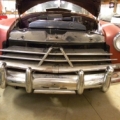Using Jeep inserts for crank bearings on the eight?
I am in the process of rebuilding the eight cylinder engine for my '50 Commodore. I remember hearing of using the Jeep shell bearing inserts for the crank bearings instead of the babbitt bearings. Can anyone steer me in the right direction for research here? Is there anybody out there who can tell me of their experience?
This makes a lot of sense to me but I would love to hear some pro/con on this procedure.
As usual, thanks guys, in advance...keith
0
Comments
-
Keith, I knew of a couple guys who used these in their 3x5 engines. I didn't follow up on the conversion but I think ultimately they went back to the poured bearings because (possibly) there was some side play in the Jeep insert bearings; they weren't the full width of the journals. At least that is what I heard.
0 -
There is no problem with side-play in the rods from '38 onwards, as they were steel sided, not babbit. However, unless the bearing shells are genuine white metal ( babbit), then you are headed for trouble. I converted a '30 H8 engine to shells using copper-lead shells from a Continental C4 engine used in Clark Forklifts and others. These appeared to work, and the owner did many thousands of miles, but eventually the engine started knocking badly and on stripping down found .008" wear in the crank journals, and no wear on the bearings. You have to bore out the rods to 2.0625" to take the shells, which cuts into the bolts, so you then have to relieve the shells and fit new bolts. Having been down this road, I would not recommend it for longevity. Another Essex motor I used Isuzu shells, and experienced severe crank wear. The problem is cutting deep enough oil grooves in the shells to give adequate lubrication and cooling. I know there are some others who have done it, but how many miles have been done since? The proof of the pudding is in the eating, as the saying goes. I'm sticking with white metal, but getting a good job done on these is another story as well!0
-
Uh oh! To easy to be true huh? I'm watching for more testimony but, I'm cautious. Thanks Geoff, for the experienced explanation...k0
-
Perhaps some specialist work on the crank would allow these shells to be used, perhaps hardening or ceramic coating, we used to have specialist process done on cranks for drag racing and in fact most applications called nitriding this increases surface hardness of the journals, the other very important thing to make sure of is that the crank is ground in the correct direction for rotation. I would think the loads on these cranks with low compression ratio is pretty low and reckon unless mistakes are made in prep most cranks should handle these materials in particular if nitrided.0
-
You are most likely correct, but for the average owner, this would be more expensive than just re-metalling the rods, and in the end, how many miles are you going to do to justify the cost? After all, the original rods were good for around 100,000 miles if not abused. Admittedly, re-poured rods are not as good as the original centrifugally spun versions, but I doubt that many cars are used as every day transport any more.Geoff0
This discussion has been closed.
Categories
- 36.9K All Categories
- 112 Hudson 1916 - 1929
- 20 Upcoming Events
- 92 Essex Super 6
- 28.6K HUDSON
- 571 "How To" - Skills, mechanical and other wise
- 995 Street Rods
- 151 American Motors
- 178 The Flathead Forum
- 49 Manuals, etc,.
- 78 Hudson 8
- 44 FORUM - Instructions and Tips on using the forum
- 2.8K CLASSIFIEDS
- 608 Vehicles
- 2.1K Parts & Pieces
- 77 Literature & Memorabilia
- Hudson 1916 - 1929 Yahoo Groups Archived Photos


